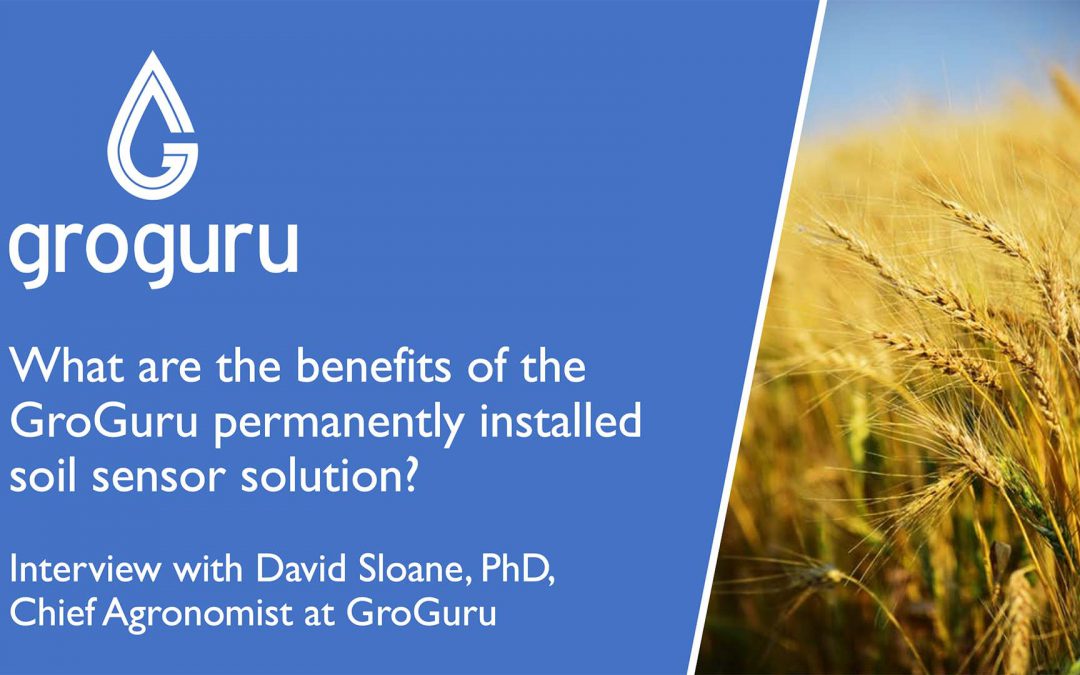What are the benefits of the GroGuru permanently installed soil sensor solution? There are quite a few! In this interview clip with Patrick Henry, CEO and our Chief Agronomist, David Sloane, they discuss the various benefits and how the GroGuru underground system helps farmers. Watch the clip here:
Patrick: When you look at GroGuru as one of our key differentiators versus the other alternatives on the market, we have a wireless underground system that allows us to permanently install the soil sensors in the ground.
The alternatives in the market today require annual install and removal because the cable from the sensors in the ground run to the above-ground telemetry. From an agronomy perspective, can you compare and contrast the benefits of the permanent install compared to the annual install/removal model?
David: An industry that I’m very familiar with is broad acre row crops. They are crops such as corn, cotton, soybeans, and wheat. You plant the crop, grow it, harvest it, and have a fallow period. What happens in the traditional sense, is that the industry today has to wait until the crop is planted. You can’t plant the crop.
You cannot pull a tine through the soil while the product is in the ground. It gets in the way. You have to wait until you’ve planted the crop. Then you have a really narrow window. It’s only a matter of weeks that you have to install the sensors so that you can then watch the roots grow and make the decisions that you want to make. Then you have to get it out of the way again coming into harvest.
If you can permanently install the sensor and get it underground, you can plant the crop overtop. You can till over the top. You can harvest over the top. That’s a game changer. In working with previous companies, and in the industry in general, it is a critical period during the install season when you’re trying to install hundreds or thousands of sensors in a very narrow period of time.
When it comes to the corn belt, you might have 10 or 15 million acres of corn, all planted within three weeks. That’s because there’s an army of people going 24 hours a day, planting the crop. You don’t have an army of people going 24 hours a day to install sensors. There is a physical limit of how many hours in the day you can put equipment out. By having it already in there, that’s awesome. It solves that scalability problem.
Patrick: You’re able to install the sensors during the off season, the dormant season, and that gives you a six-month window instead of that very narrow window of a week. Then you only have to do it once every five years.
David: Yes.
Patrick: That’s a big difference in terms of scalability.
David: It’s a massive difference in terms of scalability. It’s a game changer. You’ve turned a three or four-week installation window into a six or eight-month installation window. It gives you time to plan it out and get it done. You also get to capture all this data from the winter, which is really valuable.
In a lot of areas, like the Western Corn Belt and Ogallala Aquifer, they’re relying on stored soil moisture. You have to start the season with a full profile. You may not get it with rainfall. Therefore, you have to irrigate to fill the soil so that it’s there when you need it in the middle of the season.
Did you enjoy this video? If so, leave a comment and let us know what you liked! We appreciate your feedback! We are happy to talk with you about your specific sensor needs and benefits. Please contact us today to get started.

